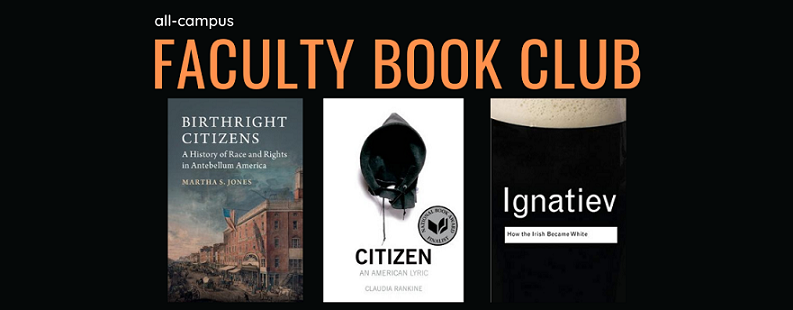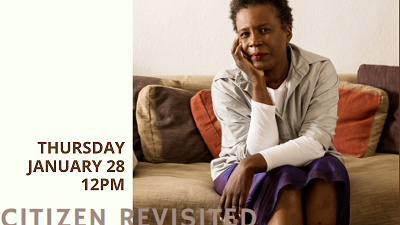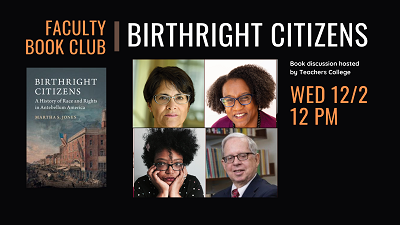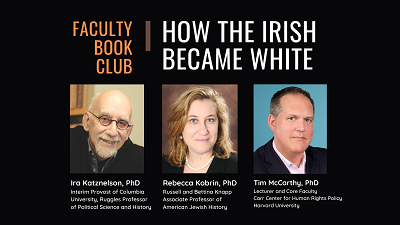All-Faculty Summer Reading Initiative

In collaboration with our colleagues at Barnard College and Teachers College, we piloted an all-faculty reading initiative. For our first round, participants chose three books, and each school hosted a faculty-facilitated book club discussion. See below for additional information and recordings of the presentations.

Citizen: An American Lyric by Claudia Rankine
Rankine, C. (2014). Citizen: an American lyric. Graywolf Press.
A provocative meditation on race, Claudia Rankine's long-awaited follow up to her groundbreaking book Don't Let Me Be Lonely: An American Lyric.
Claudia Rankine's book recounts mounting racial aggressions in ongoing encounters in twenty-first-century daily life and in the media. Some of these encounters are slights, seeming slips of the tongue, and some are intentional offensives in the classroom, at the supermarket, at home, on the tennis court with Serena Williams and the soccer field with Zinedine Zidane, online, on TV-everywhere, all the time. The accumulative stresses come to bear on a person's ability to speak, perform, and stay alive. Our addressability is tied to the state of our belonging, Rankine argues, as are our assumptions and expectations of citizenship. In essay, image, and poetry, Citizen is a powerful testament to the individual and collective effects of racism in our contemporary, often named "post-race" society.

Birthright Citizens by Martha Jones
Jones, M. S. (2018). Birthright Citizens: A History of Race and Rights in Antebellum America. India: Cambridge University Press.
12/2 Book Discussion Registration, hosted by Teachers College
Birthright Citizens tells how African American activists radically transformed the terms of citizenship for all Americans. Before the Civil War, colonization schemes and black laws threatened to deport former slaves born in the United States. Birthright Citizens recovers the story of how African American activists remade national belonging through battles in legislatures, conventions, and courthouses. They faced formidable opposition, most notoriously from the US Supreme Court decision in Dred Scott. Still, Martha Jones explains, no single case defined their status. Former slaves studied law, secured allies, and conducted themselves like citizens, establishing their status through local, everyday claims. All along they argued that birth guaranteed their rights. With fresh archival sources and an ambitious reframing of constitutional law-making before the Civil War, Jones shows how the Fourteenth Amendment constitutionalized the birthright principle, fulfilling the long-held aspirations of African Americans.

How the Irish Became White by Noel Ignatiev
Ignatiev, N., & Mazal Holocaust Collection. (1995). How the Irish became White. New York: Routledge.
10/16 Panel and Book Discussion Information
The Irish came to America in the eighteenth century, fleeing a homeland under foreign occupation and a caste system that regarded them as the lowest form of humanity. In the new country – a land of opportunity – they found a very different form of social hierarchy, one that was based on the color of a person’s skin. Noel Ignatiev’s 1995 book – the first published work of one of America’s leading and most controversial historians – tells the story of how the oppressed became the oppressors; how the new Irish immigrants achieved acceptance among an initially hostile population only by proving that they could be more brutal in their oppression of African Americans than the nativists. This is the story of How the Irish Became White.nd of opportunity – they found a very different form of social hierarchy, one that was based on the color of a person’s skin. Noel Ignatiev’s 1995 book – the first published work of one of America’s leading and most controversial historians – tells the story of how the oppressed became the oppressors; how the new Irish immigrants achieved acceptance among an initially hostile population only by proving that they could be more brutal in their oppression of African Americans than the nativists. This is the story of How the Irish Became White.
Please consider purchasing your books at your nearest independent bookstore.
This program is part of the Addressing Racism: A Call to Action for Higher Education initiative of the Office of the Vice Provost for Faculty Advancement.